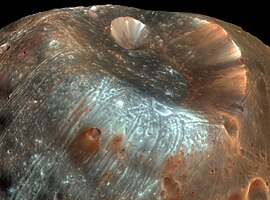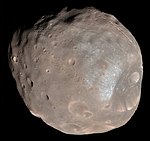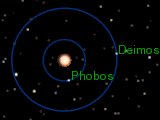Phobos (satellite)
Phobos (from the Greek Φóβoς, "fear") is the larger of the two satellites of Mars and the closest to the planet, being Demos the other satellite. Both were discovered by the American astronomer Asaph Hall (1829-1907) on August 18, 1877, with the large 66 cm refractor at the United States Naval Observatory in Washington, D.C., the work of the American optician Alvan Clark (1804 -1887). It was the discoverer himself who proposed the names, inspired by book XV of the Iliad, in which the god Ares (Mars in Roman mythology) invokes fear (phobos) and terror (deimos).
Phobos is a small satellite, irregular in shape, whose mean radius is eleven kilometers. It always presents the same face to Mars, due to the tidal anchoring exerted by the planet. It orbits about 6000 kilometers from the Martian surface, which makes it the closest satellite to its planet in the solar system. These tidal forces create a deceleration in Phobos, losing this orbital speed, which will cause its collision with Mars inside from about 50 to 100 million years, or its disintegration and formation of a ring around the planet.
History
Discovery and naming
Asaph Hall discovered Phobos on August 18, 1877 —although contemporary sources, using the pre-1925 astronomical convention that began the day at noon, point to the discovery on 17— day with the 26-inch refracting telescope at the United States Naval Observatory in Washington, inaugurated four years earlier and the most powerful by then. At this time, Hall was systematically searching for the putative satellites of Mars. On August 10, he had already seen one of the satellites, but, due to bad weather, he could not identify it the next day.
The name was suggested by Henry Madan (1838-1901), Science Master of Eton. It is reminiscent of one of the characters who accompany Ares to battle in book XV of the Iliad. Ares is the Greek equivalent of the Roman god Mars.
Following Remarks
The size and orbital characteristics of the satellites of Mars have long limited their observation to only favorable occasions: when the planet is in opposition and the two satellites reach appropriate elongations —which meet every two years approximately— or when conditions are particularly favorable — being verified roughly every sixteen years—. The first favorable configuration occurred in 1879. Many observers from around the world participated in the observations in order to accurately determine the orbits of the two satellites.
Over the next forty years, between 1888 and 1924, most observations (more than 85% of the total) were made at two US observatories: the US Naval Observatory and the Lick Observatory., was the determination of the direction of rotation of the planet. Between 1926 and 1941 only the first of the observatories continued the observations, with 311. From 1941 the observations were only made with photographic techniques.
Little or no progress was made over the next fifteen years. The investigation was resumed in 1956 aimed mainly at the identification of new satellites. In 1945 Bevan Sharpless (1904-1950) detected an acceleration of Phobos that could not be explained as the result of a disturbance in the tenuous Martian atmosphere. The information did not receive special attention until it was collected by Iósif Shklovski (1916-1985) who in 1959 proposed that the satellite could be a hollow object and speculated that it was an artificial satellite launched by an alien civilization formerly present in the planet. This hypothesis gained some notoriety. It was revived in 1966 by Shklovski himself in the book Intelligent Life in the Universe written with Carl Sagan (1934-1996). The controversy that accompanied it led to new astronomical observations of both satellites over the years. sixty and seventy' which confirmed Sharpless's initial measurement.
In 1988, coinciding with the Soviet missions of the Phobos program, Kudriavtsev and his colleagues carried out several observations. However, for the next ten years, the satellites were not observed, until 2003, when members of the Lowell Observatory made very precise observations. In 2005 they observed both satellites with the Arecibo radio telescope, which produced an estimate of the density of some surface materials.
Physical characteristics
Phobos is one of the least light-reflecting bodies in the solar system. Spectroscopically it resembles D-type asteroids, and its composition is apparently similar to carbonaceous chondrites. Phobos's density is very low for a solid rock and it is known to have significant porosity. These observations suggested that Phobos could have a substantial reserve of ice. But spectral observations indicate that the surface regolith layer is devoid of water, however the presence of ice under the regolith layer has not been ruled out.
Very faint dust rings produced by Phobos and Deimos have been predicted, but attempts to observe these rings have been unsuccessful to date. Recent images from the Mars Global Surveyor probe indicate that Phobos is covered by a layer of fine-grained regolith at least 100 meters thick; it is believed to have been created by impacts from other bodies, but it is not known how this material adheres to such a low gravity object. Phobos is highly irregular, with dimensions of 27 × 22 × 18 km. As a result of this shape, gravity on its surface varies by about 210%; the tidal effect induced by Mars doubles this variation (about 450%) because this planet accentuates Phobos's gravity at both poles by more than half.
Phobos has multiple impact craters. The most notable surface feature is Stickney Crater, named after Asaph Hall's wife. Similar to the Mimas crater called Herschel, but on a smaller scale, the impact that created it should have nearly torn Phobos to pieces. The surface is heavily grooved and lined. The furrows are generally less than 30 m deep, 100 to 200 m wide, and up to 20 km long. They were initially thought to have been caused by the same impact that created Stickney crater. However, analysis of the findings from the Mars Express spacecraft revealed that the grooves did not have a radial pattern towards Stickney crater, but that they are directed towards the apex of Phobos in its orbit (which is not far of Stickney). Researchers believe that these grooves have been excavated by material ejected into space by impacts on the surface of Mars. The grooves would then be catenas (chains of small craters in succession) and they all dilute as they reach the vicinity of Mars. Phobos vertex. The impacts have been grouped into twelve or more families of different ages, presumably representing at least twelve impact events on Mars.
The Kaidun meteorite is thought to be a fragment of Phobos, but verification has not been possible given the limited knowledge of the moon's detailed composition.
Named geological features
Geologic features on Phobos have been named after astronomers associated with the satellite, as well as after names of characters and places in the novel Gulliver's Travels by Jonathan Swift. called Laputa Regio and a plain called Lagado Planitia; both names are taken from the novel Gulliver's Travels (in fiction, Laputa is a flying island and Lagado is the imaginary capital of the fictional nation of Balnibarbi). Phobos's single crest is called Kepler dorsum, in memory of astronomer Johannes Kepler. Several craters have also been given proper names.
FUNDS
| Crater | Eponymous | Coordinates |
|---|---|---|
| Clustril | Character of The Gulliver Travels | 60°N 91°O / 60, -91 (Clustril) |
| D'Arrest | Heinrich Louis d'Arrest, astronomer | 39°S 179°O / -39, -179 (D'Arrest) |
| Drunlo | Character of The Gulliver Travels | 36°30′N 92°00′O / 36.5, -92 (Drunlo) |
| Flimnap | Character of The Gulliver Travels | 60°N 350°O / 60, -350 (Flimnap) |
| Grildrig | Character of The Gulliver Travels | 81°N 195°O / 81, -195 (Grildrig) |
| Gulliver | Main character The Gulliver Travels | 62°N 163°O / 62, -163 (Gulliver) |
| Hall | Asaph Hall, Fobos discoverer | 80°S 210°O / -80, -210 (Hall) |
| Limtoc | Character of The Gulliver Travels | 11°S 54°O / -11, -54 (Limtoc) |
| Öpik | Ernst J. Öpik, astronomer | 7°S 297°O / -7, -297 (Öpik) |
| Reldresal | Character of The Gulliver Travels | 41°N 39°O / 41, -39 (Reldresal) |
| Roche | Édouard Roche, astronomer | 53°N 183°O / 53, -183 (Roche) |
| Sharpless | Bevan Sharpless, astronomer | 27°30′S 154°00′O / -27.5, -154 (Sharpless) |
| Shklovsky | Iosif Shklovsky, astronomer | 24°N 248°O / 24, -248 (Skyresh) |
| Skyresh | Character of The Gulliver Travels | 52°30′N 320°00′O / 52.5, -320 (Skyresh) |
| Stickney | Angeline Stickney, wife of Asaph Hall | 1N 49°O / 1, -49 (Stickney) |
| Todd. | David Peck Todd, Astronomer | 9°S 153°O / -9, -153 (Todd) |
| Wendell | Oliver Wendell, astronomer | 1S 132°O / -1, -132 (Wendell) |
Orbital characteristics
Phobos' unusually close orbit of the planet Mars produces some surprising effects. Viewed from Phobos, Mars would appear 6,400 times larger and 2,500 times brighter than our full Moon as viewed from Earth, spanning a quarter of the width of a celestial hemisphere.
Phobos orbits the planet Mars below the radius of the synchronous orbit, which means that it moves around the planet faster than the planet itself rotates. For this reason it appears in the west, moves comparatively quickly across the sky (in 4 hours 15 minutes or less), and sets in the east approximately twice per Martian day (every 11 hours and 6 minutes). Because it is close to the surface and in an equatorial orbit, it cannot be seen above the horizon from latitudes greater than 70.4°.
Phobos' orbit is so low that its angular diameter, as seen by an observer on Mars, varies visibly depending on its position above the sky. Observed on the horizon, Phobos is about 0.14° wide; at the zenith it is seen with 0.20°, one third of the width of our full moon seen from Earth. For comparison, the Sun has an apparent size of about 0.35° in the Martian sky.
An observer located on the Martian surface in a suitable position could see the transit of Phobos across the Sun. The satellite is not large enough to cover the solar disk, and therefore cannot cause a total eclipse. Some of these transits have been photographed by the Martian rover Opportunity pointing its cameras towards the Sun. These transits last very little time (about half a minute), since Phobos moves relatively quickly through the Sun. firmament, in addition to the fact that the Sun is very small seen from Mars (compared to the view from Earth). During this event, the shadow of Phobos is projected on the surface of Mars moving at high speed, a shadow that has also been photographed by some space explorers.
Phobos' phases, as observed from Mars, take 0.3191 days (according to Phobos's orbital period) to cover the path, only 13 seconds longer than Phobos's same period.
Observation and exploration
Observation from Earth
Observation of Phobos from Earth is hampered by its small size and proximity to the red planet. It is only visible for a limited period of time when Mars is near opposition and appears as a single dot without solvable. Under such circumstances, it reaches magnitude 11.6. Mars with a magnitude of -2.8 is six hundred thousand times brighter. In addition, during opposition Phobos is separated by 24.6 arc seconds from the planet, making it easier to observe Deimos, which is up to 61.8 arc seconds away from the disk of Mars.
To observe it in favorable conditions, it is necessary to have a telescope of at least 12 inches (30.5 cm). CCD cameras. An object that hides the brightness of the planet and a device for taking images such as photographic plates or CCD, with exposures of several seconds, are elements of great help in the observation.
Phobos in popular culture
In the book Gulliver's Travels, Jonathan Swift describes the great astronomical knowledge existing in the imaginary country of Laputa. One of the passages seems to divine the existence of the two Martian moons:
They have also discovered two smaller stars or satellites that revolve around Mars, of which the interior differs from the center of the primary planet exactly three diameters of this, and the outer one, five; the first makes a revolution in the space of ten hours, and the last one, in twenty-one and a half; so the squares of their periodic times are almost in equal proportion to the cubes of their distance from the center of Mars, which evidently indicates that they are gravitated.Jonathan Swift, Gulliver's travels, 1726
Voltaire (1694-1778) also mentioned the two satellites of Mars in his work Micromegas, a story published in 1752 that describes a being originating from a planet of the star Sirius, and from its companion from the planet Saturn.
... As they left Jupiter they went through a space of about a hundred million leagues, and they cost the planet Mars, which, as everyone knows, is five times smaller than our blood cell, and they saw two moons that serve this planet and have not been able to discover our astronomers.Voltaire, Micromegas, 1752
In both cases, the two authors seem to have echoed a very common idea in the intellectual circles of the time, arising from the first opinions of the astronomer Johannes Kepler (before he enunciated his famous three laws), based on turn into a mystic theory related to perfect solids. The precision of the data, in both cases, is due to the mechanical calculations carried out at the beginning of the 18th century on the basis of the Universal Gravitation law, referring to what would be the rotation period and distance to Mars of a supposed body orbiting around that planet. It is therefore a serendipity, since the optics available during the lives of both authors did not allow us to see those celestial bodies that are so small and that are so little separated from the sphere of Mars.
Due to these coincidences, the two largest craters on Deimos (about 3 km in diameter each) were named "Swift" and "Voltaire".
In the Doom video game franchise, this satellite appears as a world within the video game and is important for the beginning of its plot, since it is the first place that appears in the franchise.
Contenido relacionado
Lacerta
Roche limit
Zond Program





